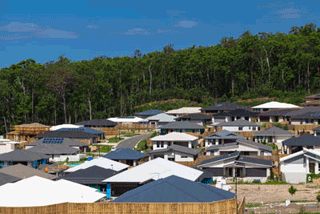Quote of the Week
“Over the past year, we have seen record demand from first home buyers, with NAB lending increasing by 6% compared to 2020. We have also seen the return of investors this year as economic conditions have improved.”
NAB executive for home ownership Andy Kerr
Prices Surge As Listings Fall
 National residential property listings dropped 4% in June, with old stock being cleared nationwide as the number of buyers outstrips sellers, pushing up property prices around the nation.
National residential property listings dropped 4% in June, with old stock being cleared nationwide as the number of buyers outstrips sellers, pushing up property prices around the nation.
Figures released this week by SQM Research indicate that the largest monthly falls in property listings were in Canberra, Hobart, Melbourne and Adelaide.
Property listings are trending downwards nationwide, which is putting upward pressure on prices as demand outstrips supply. Compared to 12 months ago, national listings fell 21.6%, with the biggest falls in Hobart, Adelaide, Canberra and Brisbane.
SQM managing director Louis Christopher says: “Notwithstanding the quieter winter season, property listings fell again in June following a drop in May. We have also seen another large fall in old listings this month, indicating old stock is being sold and new property listings aren’t offsetting this fall. This highlights there are more buyers than sellers in national property markets.”
Buying Intentions At All-time High
 Australians’ appetite for property has hit an all-time high. One in six Aussies intend to buy a new home in the next 12 months.
Australians’ appetite for property has hit an all-time high. One in six Aussies intend to buy a new home in the next 12 months.
According to a NAB survey, 15% of respondents have confirmed their home-buying intentions, compared with 13% in the previous quarterly survey.
According to NAB’s research, young Aussies are leading the increase in demand: 39% in the 18-29 group are saving to buy, while 26 % are renting but saving to buy.
“Young Australians are the most aspirational home buyers right now, and we’re seeing this with 25% of applications now done via video, with thousands more booked online every month,” NAB executive for home ownership Andy Kerr says.
But while the intent to buy is higher, optimism is still subdued, with only 40% of Australians confident that now is a good time to buy a home and 31% confident now is a good time to buy an investment – lower than last quarter’s 45% and 34%, respectively.
Investor Market Share Rising
 ABS figures show investor finance rose 13% in May, or more than 115% higher than the same time last year. Loan commitments for investor housing are at their highest level since June 2015, after falling to a 20-year low in May 2020.
ABS figures show investor finance rose 13% in May, or more than 115% higher than the same time last year. Loan commitments for investor housing are at their highest level since June 2015, after falling to a 20-year low in May 2020.
Housing credit growth is currently about 7%, or about the same level when the Australian Prudential Regulation Authority started to tighten lending standards in 2014. Canstar’s Steve Mickenbecker says: “It’s possible APRA might look to slow investor speculation to ease the path for first home buyers.”
Total lending for the month was a record $32 billion, up 95% over the same time last year with owner-occupier loans rising by a record $23.4 billion, 88% higher than last year.
CBA recently tightened buffer rates, which means it will adopt a stricter assessment of the capacity of some borrowers to repay their home loans at higher interest rates. But other lenders, such as Westpac, are set to ease lending conditions for self-employed borrowers.
Singles A Dominant Market Force
 Single Australians have overcome rising house prices to break into the property market in droves during the pandemic. Data from ME Bank shows singles accounted for 38% of all loan applications received by the bank in 2020, up from 35% in 2019.
Single Australians have overcome rising house prices to break into the property market in droves during the pandemic. Data from ME Bank shows singles accounted for 38% of all loan applications received by the bank in 2020, up from 35% in 2019.
The bank attributes their increased influence in the property market to a combination of falling prices (in some cities) and weaker competition from investors when the market faced a high degree of uncertainty last year.
But the tide is now turning. ABS data shows new home loans for investors rose 13% to $9.1 billion in May – the highest level since June 2015. At the same time, the number of loan commitments to FHBs fell 0.8% – the fourth consecutive monthly decline in the number of FHBs.
But although the drop has coincided with the return of investors, the broader picture is still one of historically high levels of FHB activity. Loans to investors accounted for only 28% of total home loan commitments in May – much lower than their 46% share in 2015.
UBS Tips Boom To Continue
 In the absence of significant policy tightening by regulatory authorities, the property boom is set to continue, according to UBS. Despite renewed lockdowns in the last two months, annual house price growth is now likely to crack 15% in July and the up-cycle is set to continue.
In the absence of significant policy tightening by regulatory authorities, the property boom is set to continue, according to UBS. Despite renewed lockdowns in the last two months, annual house price growth is now likely to crack 15% in July and the up-cycle is set to continue.
The latest data indicates housing credit should accelerate to 7% year on year over the coming months, versus 4.8% in the year to May.
UBS chief economist George Tharenou says APRA intervention is unlikely. He says the limited rise in higher-risk loan types “suggests a policy shift is unlikely until next year”.
With the number of dwelling sales continuing to outpace the rise in new listings, the stock on the market remained a low 25%, which was below the five-year average. Rents have started rising sharply, with a 6.6% annual rise the strongest since 2009.
Tharenou estimates that household wealth has risen 18% or a record $2 trillion in year-on-year terms in the June quarter, to more than $500,000 per person.




